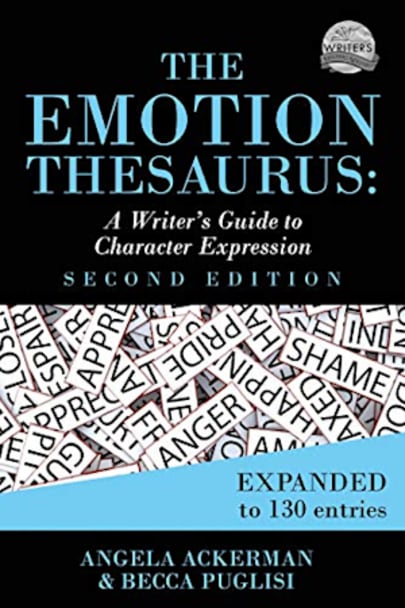The bestselling Emotion Thesaurus, often hailed as “the gold standard for writers” and credited with transforming how writers craft emotion, has now been expanded to include 55 new entries!One of the biggest struggles for writers is how to convey emotion to readers in a unique and compelling way. When showing our characters’ feelings, we often use the first idea that comes to mind, and they end … mind, and they end up smiling, nodding, and frowning too much.
If you need inspiration for creating characters’ emotional responses that are personalized and evocative, this ultimate show-don’t-tell guide for emotion can help. It includes:
- Body language cues, thoughts, and visceral responses for 130 emotions that cover a range of intensity from mild to severe, providing innumerable options for individualizing a character’s reactions
- A breakdown of the biggest emotion-related writing problems and how to overcome them
- Advice on what should be done beforedrafting to make sure your characters’ emotions will be realistic and consistent
- Instruction for how to show hidden feelings and emotional subtext through dialogue and nonverbal cues
- And much more!
The Emotion Thesaurus, in its easy-to-navigate list format, will inspire you to create stronger, fresher character expressions and engage readers from your first page to your last.
more



Another great resource for authors.
Most writers struggle with getting just the right expression for an emotional state. This book will help you overcome any tendency to repeat yourself, or fall into hackneyed terms. It contains a listing of a huge number of emotions, and lots of details on how characters express it without words.
Highly recommended for writers of all levels.
I want to scream from the rooftops to every author out there: go get this book! We’re constantly told to “show, don’t tell,” but finding the right way to show can make all the difference in the world between a scene that merely goes through the motions and one that that brings the reader deep into the story and allows them to get lost. THE EMOTION THESAURUS is part how-to, and part reference. After learning how to use the guide, there are 130 entries to help you find the right way to show character emotions. With helpful cross-references it’s easy to find the right way to show escalation from anger to rage or de-escalation to mere annoyance. All the body language, both internal and external, can be used to kickstart the analogies and symbolism necessary to tell a compelling story. Because weak verbs can be the death of good writing, the authors also include power verbs for each entry to further stimulate creative writing. And finally, each entry includes helpful writing tips, such as:
Pay special attention to the events leading up to an emotional response. If the plotting feels contrived, the character’s emotion will feel contrived as well.
Each entry includes physical signals, behaviors, internal sensations, mental responses, long term responses to an emotion, and signs that an emotion has been suppressed rather than dealt with, providing all the pieces to construct dazzling scenes.
Bottom Line
One of the best references for creative writing I’ve ever read.
A valuable reference book for writers and storytellers of all kinds. I refer to it every time I sit down to write!
This book is always beside me on my desk when I do a big rewrite of my drafts. I go back and try to replace as many of my “she felt angry, she felt cold, she felt scared…” with direct bodily sensations. This makes my writing far more immediate to the reader.
I use this handy emotion thesaurus to find better ways of expressing what I’m trying to get across. These authors publish a whole series of guides and they are all excellent reference books to have in your writerly library.